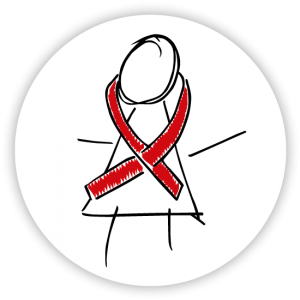Preconception safety signal with dolutegravir: data from the Tsepamo study
3 August 2018. Related: Conference reports, Pregnancy, Paediatric Workshop 10 Amsterdam 2018.
 Polly Clayden, HIV i-Base
Polly Clayden, HIV i-Base
More details from the Tsepamo study, Botswana, which identified a potential safety signal with preconception dolutegravir (DTG) exposure, were shown at the 10th International Workshop on HIV Paediatrics. [1]
We have described this study previously in HTB, as well as the statements following the safety signal, since these were released in May 2018. [2,3,4]
Rebecca Zash presented data on behalf of the study group. She explained that Tsepamo started in August 2014 to look at birth outcomes by HIV status and ART regimen and to see if there is an increased risk of neural tube defects (NTDs) in infants exposed to efavirenz (EFV) from conception.
The original plan was a four-year analysis (to August 2018) to compare the prevalence of NTDs in infants born to women on EFV at conception vs other ART regimens. The sample size of 94,000 births was based on ability to detect a 2-fold increase in NTDs with the assumption of 0.1% prevalence.
Mid-2016 Botswana changed first-line ART from an EFV-based to a DTG-based regimen. Recently published data from women who started DTG during pregnancy showed no difference in adverse birth outcomes compared with those who started EFV. [5] There was no increased risk of birth defects among 280 women who started DTG in the first trimester.
The Tsepamo group were asked to provide any preliminary data on outcomes for women who started DTG before conception for WHO guidelines committee in May 2018.
At the time of analysis there had been 89,064 births at eight surveillance hospitals: 21,955 among HIV positive mothers; 11,726 of these who received ART from conception; and 426 (3.3%) of these were on a DTG-based regimen. Of the remaining 11,300 mothers on ART from conception, 5,787 received EFV.
Overall, 86 NTDs were identified among 88,755 births: 0.1% (95% CI: 0.08 to 0.12).
There were 4/426 NTDs in infants born to women receiving DTG at conception: 0.94% (95% CI: 0.37 to 2.4). This compared with 14/11,300 among non-DTG at conception exposures: 0.12% (95% CI: 0.07 to 0.21). And 3/5787 EFV at conception exposures: 0.05% (95% CI: 0.02 to 0.15).
There were 0/2812 NTDs in infants born to mothers who started DTG during pregnancy: 0% (95% CI: 0 to 0.13). And 61/66, 057 among those born to HIV negative mothers: 0.09% (95% CI: 0.07 to 0.12).
The lower bound of the DTG-exposures’ confidence interval did not overlap with any of the other exposure groups.
The four defects were: encephalocele, anencephaly, myelomeningocele, and iniencephaly.
None of the women were reported to be on folate supplementation before pregnancy – this was similar across exposure groups.
Review of maternal data found no other risk factor for NTDs and there was no clustering by site. A sensitivity analysis, restricted to births occurring after the rollout of DTG, showed there was no increase in NTDs overall.
To check for differences in assessment the investigators looked at prevalence of post-axial polydactaly and found no differences across exposure groups compared with an expected rate of about 1%.
This preliminary signal for NTDs needs further data to confirm or refute.
Dr Zash emphasised that, although statistically significant, the signal is based on only four cases and the absolute prevalence difference of about 0.8% is small. She also noted that the different defects among the DTG-exposed at conception infants is unusual.
Tsepamo continues to collect data and the investigators hope to have over 1200 births with DTG exposure to report by end of March 2019. In this analysis, they will also evaluate all major abnormalities and adverse birth outcomes.
She concluded that, in the meantime, we need to:
Improve pregnancy outcomes
- Improve access to contraception, comprehensive sexual and reproductive health services for HIV positive (and all) women.
- More countries can implement folate supplementation of grain and ensure that women of reproductive age are folate replete before pregnancy.
- Improve infrastructure for viral load monitoring and resistance testing for people who may remain on EFV.
Implement more/better surveillance for ART safety in pregnancy
- Is the DTG signal real? If so, is it a class effect? If so, in all settings?
- Will tenofovir alafenamide (TAF) be safe (and in which regimens)?
- Which PI is safest?
- What is the plan to work out whether BNABs, vaccines, long-acting ART, etc are safe in pregnancy?
comment
This was the first public presentation of the Botswana DTG preconception data.
Updates to these data, as well as findings from elsewhere, interpretations and implications will be shown and discussed at AIDS 2018. [6]
References
- Zash R. Special session: Birth defect surveillance – Tsepamo Study. 10th International Workshop on HIV Paediatrics. 20 –21 July 2018.
- Clayden P. Efavirenz, tenofovir and emtricitabine associated with fewest adverse birth outcomes in Botswana. HTB. 27 February 2017.
https://i-base.info/htb/31313 - Clayden P. Potential safety signal for dolutegravir from the time of conception. HTB. 21 May 2018.
https://i-base.info/htb/34133 - Clayden P. Dolutegravir preconception signal: time is up for shoddy surveillance. HTB. 11 July 2018.
https://i-base.info/htb/34459 - Zash R et al. Comparative safety of dolutegravir-based or efavirenz-based antiretroviral treatment started during pregnancy in Botswana: an observational study. Lancet Glob Health. Published online 4 June 2018.
https://www.thelancet.com/journals/langlo/article/PIIS2214-109X(18)30218-3/fulltext - Safety of Dolutegravir in pregnancy: Late breaking findings, interpretations, and implications. AIDS 2018. Amsterdam. 23–27 July 2018. Symposia session.
http://programme.aids2018.org/Programme/Session/1589

